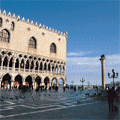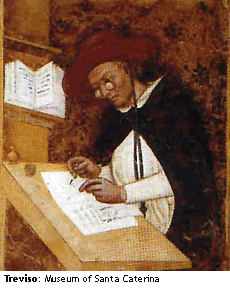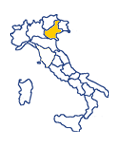Churches and Museums
The Duomo has a Neoclassical appearance, but its origins are much older. The exterior has an impressive Neoclassical facade, the interior houses a crypt from 1100 and the Cappella Malchiostro, with altarpiece by Titian and other lovely works. The simple mass of the 11th century Baptistery stands to the side of the Duomo. It contains frescoes with a Byzantine influence.
San Nicolò is a large Dominican church, built with austere Gothic lines. The interior is simple and solemn. Don't miss the Dominican Chapter Hall in the adjacent Seminary Vescovile, which contains a great fresco cycle by Tomaso da Modena, one of the best painters of the 14th century. The frescoes are a series of full figure portraits of the most famous Dominicans in history: two popes, 18 cardinals and 17 Dominican monks.
San Francesco is beautiful in its extreme simplicity. The church dates back to the 13th century and contains the tomb of Dante Aligheri's sons. The wood ceiling in the form of a ship bottom is very beautiful and decorated like the vault of heaven.
Santa Lucia and San Vito behind the central Piazza dei Signori stands this complex of medieval churches. The two churches are communicating and form one of the city's most interesting religious spaces. The interior houses 14th century frescoes by Tommaso da Modena and many other outstanding works of art.
Museum of Santa Caterina, the complex is situated in the former convent of Santa Caterina, where it is possible to visit the Chapel degli Innocenti and the "Storie di S. Orsola" fresco cycle by Tommaso da Modena, one of the best 14th century painters. The fresco cycle tells the story of Saint Ursula, the Catholic daughter of the King of England, who became a martyr in Cologne in a vain attempt to convert the Huns. The former convent is now home to a museum and regularly hosts art and archeology exhibits.
Town Museum "L. Bailo" The city museum is located in a former Jesuit monastery. It includes various sections: the archeology section contains Veneti and Roman objects and funerary items. The Pinacoteca follows the artistic evolution from the Renaissance to 19th century and includes works by Lorenzo Lotto, Titian, Jacopo da Bassano, Sebastiano Ricci, Tiepolo and many others. The Galleria d'Arte Moderna features art from Naturalism at the end of the 19th century to the second half of the 20th century, with canvases by painters who worked in Treviso.
Casa dei Carraresi is located in a pedestrian area overlooking the river Cagnan and the Pescheria. The building dates back to the 13th century, and after careful restoration, it has become the most important venue of temporary exhibitions in Treviso.
Photos courtesy of: Provincia di Treviso – Assessorato Turismo, Servizio Turismo
Go to directories of the Web Sites
|






